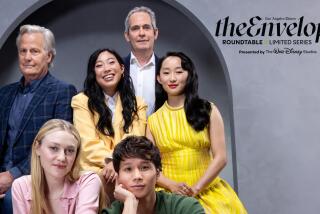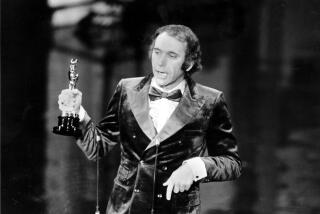Indie Focus: ‘The Rum Diary’ pours forth anew
- Share via
Though “The Rum Diary” began as a semiautobiographical novel about a young journalist in Puerto Rico written by the pre-fame Hunter S. Thompson, in many ways the book also belongs very much to Johnny Depp.
Depp came across the manuscript, begun in 1959 and not published until nearly 40 years later, while rummaging through Thompson’s papers alongside the writer in the years before his death. And Depp now stars in and helped produce the film version of “The Rum Diary,” opening Friday.
The actor selected and pursued Bruce Robinson to write and direct the adaptation, even though Robinson lives on a remote farm in England and has not made a film for nearly 20 years.
Nominated for an Academy Award for his screenplay for “The Killing Fields” in 1984, Robinson is best known for making the eminently quotable 1987 cult fave “Withnail and I” as well as the savage 1989 satire “How to Get Ahead in Advertising.” He most recently directed the disastrously dispiriting 1992 Hollywood thriller “Jennifer 8.”
In interviews, Depp has said that the 65-year-old came out of retirement to direct the film, but Robinson himself points out this is not wholly accurate.
“Johnny says that, and it’s a bit of hyperbole in a sense because I’m a writer. I write like a fiend, every day of my life I’m writing,” Robinson said recently in Los Angeles. “But in terms of trying to be a film director, that has some accuracy because I wasn’t going to do it ever again. And very flattering and kind of curious it was to be hounded by the world’s No. 1 film star.”
In the film Depp plays Paul Kemp, a down-on-his-luck American journalist writing for an English-language newspaper in 1960 San Juan. Between his besotted colleagues (Michael Rispoli and Giovanni Ribisi) and high-tension boss (Richard Jenkins) his prospects do not look bright. That is, until he meets Sanderson (Aaron Eckhart), a businessman looking for Kemp to write favorably about local land development schemes. Sanderson is a man not above dangling the beautiful Chenault (Amber Heard) to ensnare Kemp in a crucible of corruption and ambition.
If the full-gonzo Thompson that Depp played in the 1998 film version of “Fear and Loathing in Las Vegas” is some kind of impervious superhero, “The Rum Diary” is in many ways his origin story.
Robinson has about him the easy charm and low-key elegance of a rock star in repose, looking rather at home on the shady patio of the same West Hollywood luxury hotel that figures derisively in “Smoking in Bed,” his book-length series of conversations about writing and moviemaking published in 2000. By his own count, he has written four novels and published one, “The Peculiar Memories of Thomas Penman,” and written some 46 screenplays, of which 39 or 40 are unproduced.
At a recent press conference in Beverly Hills for the film, Depp recalled that when he and Thompson, who died in 2005, first discussed the idea of a “Rum Diary” film, “Bruce was the dream” even though they knew that Robinson was “unavailable, by choice.” Yet through Depp’s persistence, he was able to persuade the writer to direct once again.
“First, ‘Withnail and I,’” said Depp of why he felt so strongly Robinson was right for the job. “If there is any cinema that can be deemed perfect, ‘Withnail and I’ is there — poetic, incredible gravity, huge humor and absurdity, irreverence and all these elements and ingredients that I find fascinating in cinema. And then you go on to ‘How to Get Ahead in Advertising,’ and that was like a ball-peen hammer to the middle of my forehead.
“These two films destroyed me. I knew I had to work with him one way or another, by hook or by crook. So I hooked him.”
For “The Rum Diary” Robinson takes considerable license with Thompson’s novel, combining two main characters into one, switching the affections of Chenault from one character to another and crafting the narrative engine of a shady land development deal. By his own count there are two lines of dialogue from Thompson’s book in the film. Before writing he read the book twice, did his own research into the history of Puerto Rico and took off from there.
“I couldn’t keep asking myself, ‘What would Hunter Thompson do here?’” Robinson said. “You can’t write like William Shakespeare, you can’t write like Hunter Thompson, you can only write like yourself.”
The film was shot in Puerto Rico starting in summer 2009. Many of the people on the production team, such as cinematographer Dariusz Wolski and costume designer Colleen Atwood, had worked with Depp before. First assistant director Peter Kohn had worked not only with the actor but on Robinson’s “Withnail and I” and “Advertising” as well. All of which helped to ease the writer’s transition back on-set as director after such a long break from behind the camera.
“I think at the beginning of the shoot Bruce definitely had some insecurities; it had been a long time for him, and it’s not like he had a body of 50 movies either,” said producer Graham King. “But when he saw that we were all there to help, for him, it really came together.”
Robinson met Hunter S. Thompson only once, more or less in passing in the early 1990s at the Chateau Marmont in Los Angeles, and the two barely spoke a word to each other — “I didn’t have anything to ask him, and he certainly didn’t have anything to say to me.” Despite the respect the production had for Thompson — Depp had a chair with the writer’s name on it placed on-set every day — Robinson felt he had to make his own movie.
“We’re shooting the screenplay and not referring constantly to Hunter,” Robinson said. “I don’t mean this in a facetious way, but the reverence was for the material we were making into a film and no longer the book or Hunter. But Hunter’s spirit was there all the time.”
More to Read
The biggest entertainment stories
Get our big stories about Hollywood, film, television, music, arts, culture and more right in your inbox as soon as they publish.
You may occasionally receive promotional content from the Los Angeles Times.











